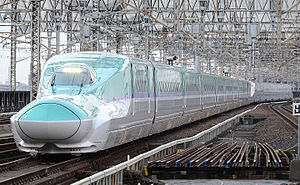H5 series
| H5 series | |
|---|---|

Set H1 on a Hayabusa service in March 2016
|
|
| In service | 26 March 2016 - |
| Manufacturer | Hitachi, Kawasaki Heavy Industries |
| Constructed | 2014–2015 |
| Number built | 40 vehicles (4 sets) |
| Number in service | 40 vehicles (4 sets) |
| Formation | 10 cars per trainset |
| Fleet numbers | H1–H4 |
| Capacity | 731 (658 Ordinary, 55 Green, 18 Gran Class) |
| Operator(s) | JR Hokkaido |
| Line(s) served | Tohoku Shinkansen, Hokkaido Shinkansen |
| Specifications | |
| Car body construction | Aluminium alloy |
| Maximum speed | 320 km/h (200 mph) |
| Electric system(s) | 25 kV AC, 50 Hz overhead catenary |
| Current collection method | Pantograph |
| Multiple working | E6 series |
| Track gauge | 1,435 mm (4 ft 8 1⁄2 in) |
The H5 series (H5系?) is a Japanese Shinkansen high-speed train type owned by Hokkaido Railway Company (JR Hokkaido) for use on Tohoku and Hokkaido Shinkansen services since 26 March 2016. Based on the earlier E5 series trains, a total of four 10-car sets were built by Hitachi and Kawasaki Heavy Industries at a cost of approximately 18 billion yen. The first two sets were delivered in October 2014.
As of 26 March 2016[update], H5 series trainsets work in a pool with similar JR East E5 series trainsets, and are used on the following services on the Tohoku and Hokkaido Shinkansen lines:
The H5 series is the first JR Hokkaido train type to use the "H" prefix, following the method used by JR East (with an "E" prefix).
The H5 series is directly based on the E5 series trains operated by JR East on the Tohoku Shinkansen since 2011, and has an identical maximum operating speed of 320 km/h (200 mph), although this is limited to 260 km/h (160 mph) on the Hokkaido Shinkansen, and to 140 km/h (85 mph) on the dual gauge track extending through the undersea Seikan Tunnel connecting Hokkaido with mainland Honshu. All cars feature active suspension, and tilt by up 1.5 degrees through curves, allowing the maximum speed of 320 km/h to be maintained even on curves with a radius of 4,000 m. The units feature a number of cold-weather improvements, including an upgraded snowplow on the lead units, durable rubber to protect the various connections between cars and a stainless-steel underframe to protect the electronics (upgraded from the usual aluminium underframe protection for added durability).
...
Wikipedia
